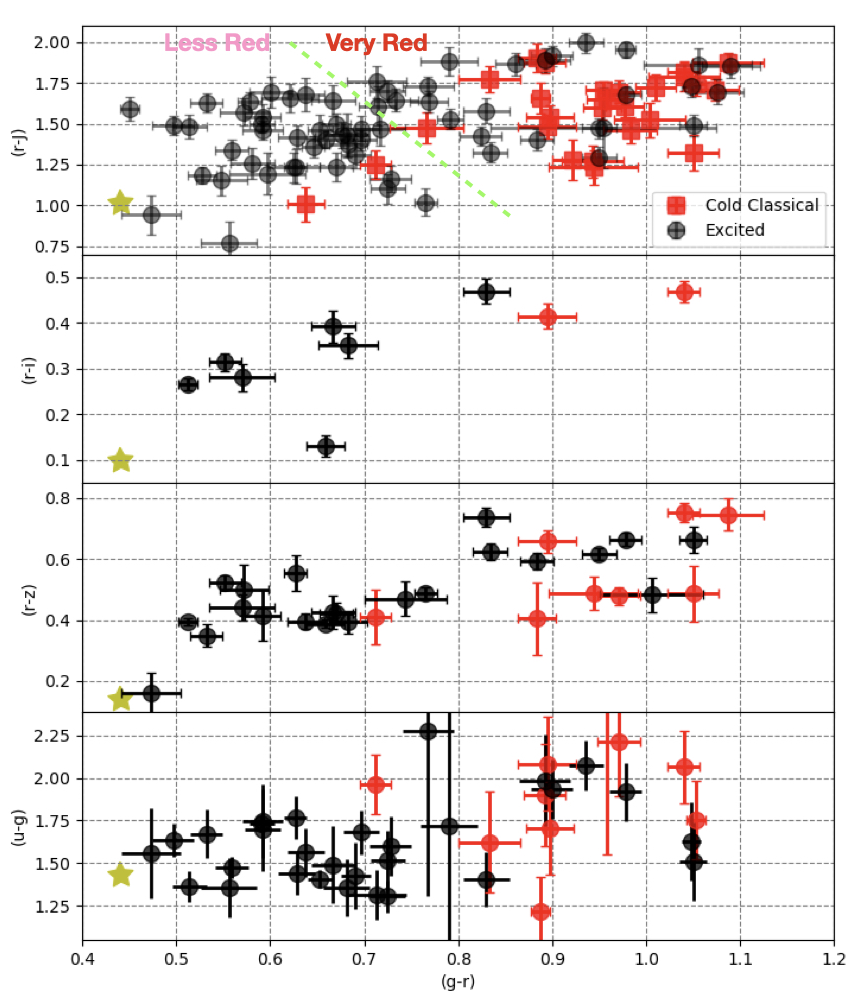For 6 years now, I've been leading the survey we titled, Colours of the Outer Solar System Origins Survey, or Col-OSSOS for short. The basic idea is to gather UV-optical-NIR colours of a wack of Kuiper Belt Objects with a number of constraints that astronomers like (eg. brightness-complete, understood biases, high data quality, etc.). We've been using the Gemini-North telescope (it was one of Gemini's first Large Programs) and the Canada-France-Hawaii telescope to observe targets simultaneously (which is totally bad-ass). We have also had some observations from the Subaru telescope - yes we had all three telescopes going simulanesouly, once. In short, the project is a beast! If you want more details, checkout the Col-OSSOS project page, and our paper by Dr. Megan Schwamb which gets into all the nitty gritty involved in making such a project happen.
The main figure from this program is shown below. I refer to this as the 4C plot because it shows the four separate colours we gather for the program. I love this plot for a couple reasons. The first is just how clearly the different compositional classes appear in this plot, most notably in the (g-r) vs. (r-J) and (g-r) vs. (r-z) plots. Dynamically, the different Kuiper Belt Object (KBO) classes are shown by different coloured points. The dynamically excited KBOs (black) fall into two classes, which we've know about for a while, and the so-called cold classical KBOs (red), which fall into a third class (one of the results from Col-OSSOS).

I also really like this plot because it clearly shows the correlated optical-NIR colours of the dynamically excited classes. This was something I found in 2012 with the H/WTSOSS program, so it's really great to have this confirmed here. We think those colour correlations are due to compositional mixing. That is, all objects in a class broadly consist of the same compositional building blocks. Then, what determines an object's colour is how much those components are mixed, with objects on the red-end of a class having one mixture, and those on the blue-end having a different mixture. The separate classes have different sets of compositional building blocks. But I digress.
There are lots of neat things coming out of Col-OSSOS, which I will talk about in separate posts in the coming days. I'm especially excited to talk about my discovery of the blue-binaries, and what this means for how we think planetesimals formed. We just recently confirmed the existence of these special objects. So I expect the interpretations to start rolling in.
Publications
We've admittedly been a bit slow to publish. We have a couple coming this year. Here's an up to date list of our published works:
- TRIPPy: Trailed Imaging Photometry in Python
- All Planetesimals Born Near the Kuiper Belt Formed as Binaries
- Col-OSSOS: z-Band Photometry Reveals Three Distinct TNO Surface Types
- Col-OSSOS: Colors of the Interstellar Planetesimal 1I/‘Oumuamua
- Col-OSSOS: Color and Inclination Are Correlated Throughout the Kuiper Belt
- Col-OSSOS: The Colors of the Outer Solar System Origins Survey
The Team
There are many many folks helping with this program. Here's a non-exhaustive list (in no particular order) of all the awesome people I get to work with on this project:
- Michele Bannister
- Megan Schwamb
- Michael Marsset
- Rosemary Pike
- JJ Kavelaars
- Susan Benecchi
- Nuno Peixinho
- Matt Lehner
- Shiang-Yu Wang
I'd also like to shout out to Andy Stephens from Gemini, who has been particularly instrumental in helping get this project to succeed.